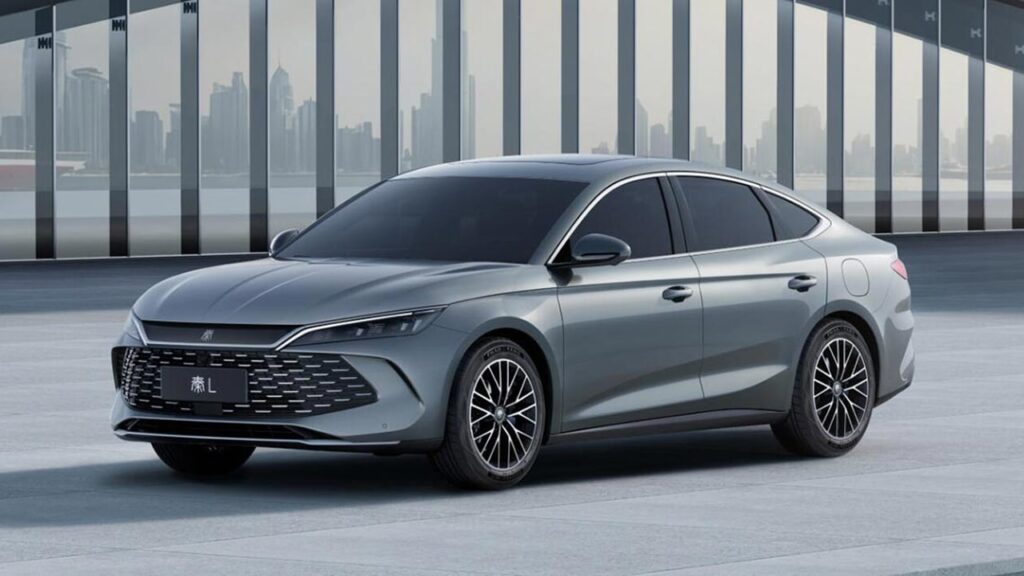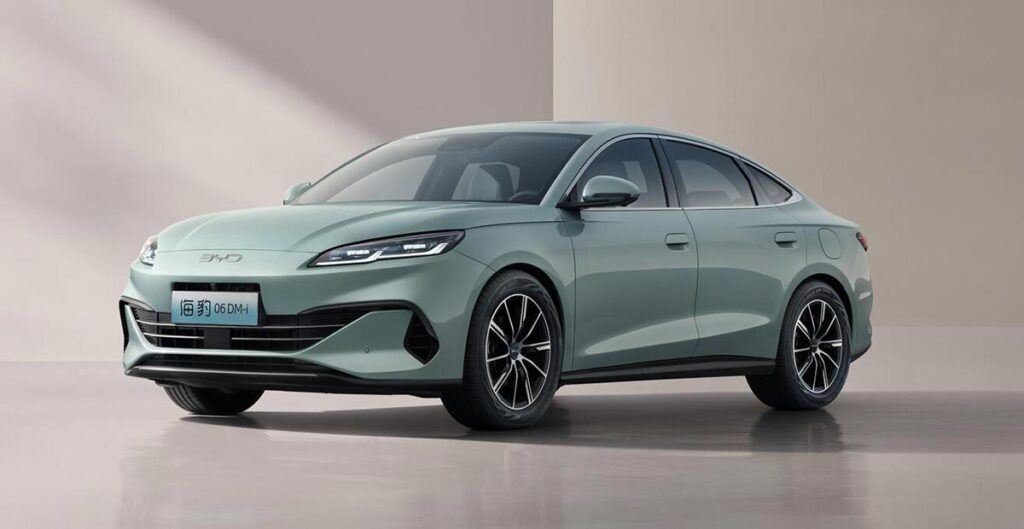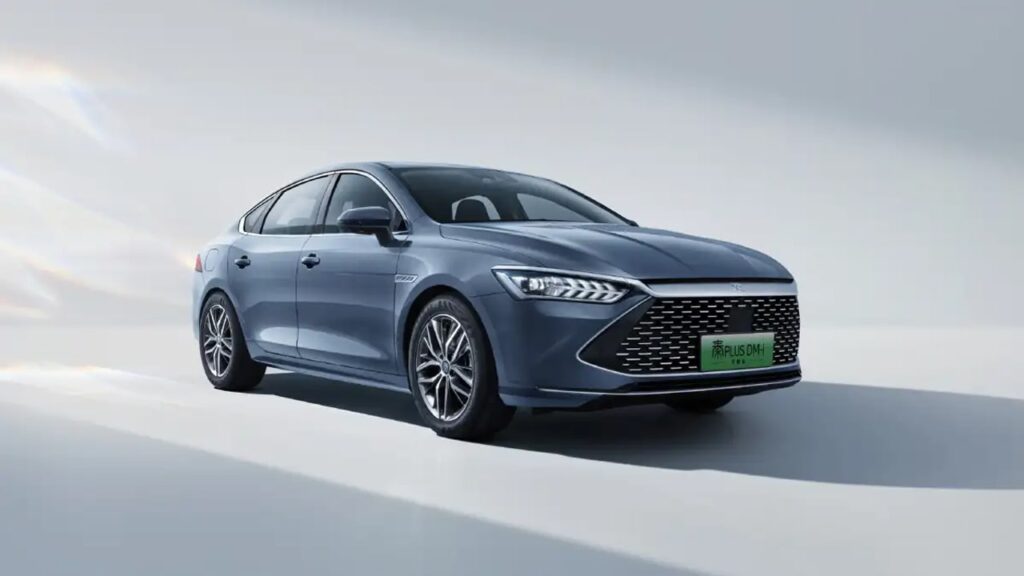At the dawn of 2024, BYD chairman Wang Chuanfu announced that the next three years would be a decisive period for the automotive industry. On May 28, BYD officially launched the fifth-generation DM system, debuting in the new Qin L and Seal 06 electric vehicle models, which were immediately put into mass production.
The fifth-generation DM system achieves a fuel consumption of 2.9 liters per 100 kilometers on a depleted battery and a combined range of 2,100 kilometers. The Qin L DM-i and Seal 06 DM-i are priced between RMB 99,800–139,800 (USD 13,770–19,290). Both models consume roughly one-third the fuel of conventional cars while offering three times the range.

BYD updates its technology every three years. In 2021, BYD launched the fourth-generation DM technology. “In the third month after its release, we started planning the next generation, aiming to reduce fuel consumption to below three liters,” an engineer told 36Kr.
The DM technology has driven the sales surge of BYD’s plug-in hybrid models. According to 36Kr, the fifth-generation DM technology has gone through numerous iterations.
Currently, the sales growth of pure EVs has significantly slowed due to limited charging efficiency. Tesla, a leader in the pure electric market, has started global layoffs. Plug-in hybrid and extended-range models are set to drive the penetration rate of new energy vehicles. In 2023, sales of plug-in hybrid models in China grew 85% year-on-year, far exceeding the 24.6% growth of pure electric models.
The launch of BYD’s fifth-generation DM system has increased the range of RMB 100,000-level plug-in hybrid models to over 2,100 kilometers, posing a significant challenge to similarly priced joint venture-produced gasoline cars that haven’t been updated for years, potentially surpassing the impact of the Honor Edition models.
Improving efficiency to the extreme
BYD’s DM technology features a primarily electric power architecture, which is the foundation for achieving lower energy consumption and higher thermal efficiency.
Higher thermal efficiency means that the same amount of fuel can generate more electricity for the battery, directly enhancing the vehicle’s range. An engineer explained that, in the era of fuel-powered vehicles, engines had to handle various conditions, making it difficult to introduce new technology. In contrast, BYD chose to simplify engine conditions and let the electric motor handle more. The simpler the engine conditions, the more apparent the improvement in thermal efficiency.
“Previously, engines handled 100% of the conditions—now, BYD’s engines handle only 20%. With fewer conditions for the engine, there’s more room for technical improvements.”
Nonetheless, improving the engine remains key to achieving higher thermal efficiency. Thus, automakers continue to work on enhancing engine performance. BYD’s approach to the engine is to keep it operating in its high-efficiency range as much as possible. “Either it doesn’t work at all, or when it starts, it minimizes the time spent in high-fuel-consumption conditions,” an engineer told 36Kr. BYD defines the high-efficiency range as having an engine thermal efficiency greater than 38%.
Another indicator for engines is the compression ratio. Thermal efficiency increases with higher compression ratios, but the difficulty grows exponentially. To raise the compression ratio, BYD conducted over 240 combustion combination experiments.
However, increasing the compression ratio can cause engine knocking, reducing power and speed, and causing instability and overheating in the cooling system. To address knocking, BYD also conducted over a hundred cooling experiments. After various enhancements, BYD increased the engine compression ratio from 15.5 to 16. The increase might seem small, but it was highly challenging.
As a result, BYD’s high-efficiency engine for plug-in hybrids achieved a thermal efficiency of 46.06%. For comparison, Great Wall Motor’s Hi4 hybrid system has a thermal efficiency of 41.5%, and Chery’s Kunpeng Super Hybrid is at 44.5%.
Additionally, the fifth-generation DM technology features an electric hybrid system (EHS) that has a power density increase of 70.28%, significantly reducing energy flow path losses and achieving an overall efficiency of 92%. This means that, alongside improving thermal efficiency, energy loss is also greatly reduced.
To reduce energy loss, BYD calculates the conduction efficiency between components. The fewer components, the less energy loss, and thus higher efficiency. A BYD representative told 36Kr that, compared to the fourth generation, the latest version’s most significant difference is its seven-in-one powertrain controller, which has a higher degree of integration.
While reducing components, BYD also improves the efficiency of existing components. For instance, the fifth-generation DM system uses simulation technology to minimize energy loss from the power transmission shaft to the tires before making actual improvements.
In addition to the new system’s efficiency, BYD is also working toward reducing fuel consumption by optimizing other vehicle components. For example, BYD replaced the lead-acid battery in the Qin L and Seal 06 with a 12-volt lithium iron phosphate (LFP) battery, saving 0.1 liters of fuel.
BYD even adjusted many details of the vehicle body, such as active air intake grilles, low drag calipers, and ultra-low rolling resistance tires, all aimed at reducing wind resistance, improving efficiency, and increasing range.
These efforts are the advantages of BYD’s fifth-generation DM system, which expands the efficiency range of each component as much as possible. After various subtle improvements, BYD achieved a range of 2,100 kilometers for the Qin L and Seal 06, three times that of fuel-powered vehicles. The fuel consumption on an empty battery is as low as 2.9 liters per 100 kilometers, one-third that of fuel vehicles.

Vertical integration of supply chain capabilities
Reducing fuel consumption is a systematic project that requires not only the DM system but also other components to cooperate. This is where BYD’s vertically integrated supply chain comes into play, developing components that are “best suited” for BYD’s vehicles.
Simply put, BYD’s engine improvements also set higher requirements for the power battery and electric drive system, as many transient conditions rely on electric drive. Thus, the fifth-generation DM system requires simultaneous improvements in batteries, thermal management, and more.
Battery technology improvements are also a foundation of BYD’s DM system. “Previously, battery technology had too low a discharge rate, but now it can keep up with the motor’s development, surpassing engine performance indicators,” an engineer told 36Kr.
BYD designed the latest generation of blade batteries specifically for its plug-in hybrid vehicles, with a feedback rate of up to 5C and a discharge rate of 16C.
Moreover, the greatest improvement in this generation of plug-in hybrid blade batteries is the cooling system. In the previous generation, BYD used a T-shaped cooling plate design, which didn’t fully cover the battery pack. The new generation adopts an S-shaped cooling plate design, improving temperature uniformity by 45%.
The working temperature of a battery pack is generally required to be within 45 degrees Celsius, and a regional temperature difference not exceeding 5 degrees Celsius. Water cooling can achieve this relatively easily because water circulates. Although direct cooling with refrigerant has better direct cooling and heating effects, it is ultimately a gas-liquid and unevenly distributed mixture, making temperature uniformity difficult to ensure.
After improvements, a BYD engineer told 36Kr that the new generation of blade batteries’ refrigerant technology can maintain temperature differences within 2 degrees Celsius.
Additionally, the new generation of battery packs has an energy density increase of 15.9%, making the battery packs smaller. The fifth-generation DM system’s higher integration saves space, allowing for a larger fuel tank. The Qin L’s fuel tank has been upgraded from 48 liters in the Qin Plus to 65 liters. For comparison, a typical small SUV’s fuel tank can hold around 50 liters.

On the cost side, the cost reduction of key components has also given BYD more leeway in its pricing strategy.
A BYD representative told 36Kr that “The main chip in the powertrain controller has 5–6 units. During the chip shortage in 2021, one controller chip cost over RMB 400 (USD 55). Now, it can be bought for RMB 50 (USD 7). A vehicle has over 100 chips, and just this cost reduction can lower the cost to one-tenth of 2021 levels.”
Additionally, the continuous decline in the prices of upstream raw materials for power batteries in the past two years has also given BYD’s self-made batteries a cost advantage. BYD’s blade batteries use LFP materials, and in the domestic market, BYD can compete with CATL in terms of LFP installation. According to 36Kr, an industry insider claimed that BYD’s cost in procuring LFP materials is even lower than CATL’s.
The most significant advantage of reduced core component costs is the lowering of new car prices. The Qin L and Seal 06 start at RMB 99,800, the same as the 2023 Qin Plus Champion Edition.
BYD’s advantage in vertically integrating its supply chain allows it to design more suitable technologies for its models at a more cost-effective price.
Now, BYD’s models and technology have reached a point of renewal. The launch of the fifth-generation DM system and the Qin L and Seal 06 has shown the market BYD’s potential. The day after the launch event, BYD’s stock price rose over 8%.
Aiming for sales of 3.6 million units this year, BYD is gradually revealing its strategies. Under Wang’s charge, the battle to expand the success of NEVs and break through the traditional automotive stronghold is intensifying.
KrASIA Connection features translated and adapted content that was originally published by 36Kr. This article was written by Han Yongchang for 36Kr.

